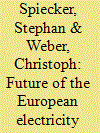| Srl | Item |
| 1 |
ID:
127207


|
|
|
|
|
| Publication |
2014.
|
| Summary/Abstract |
the ongoing transformation of the European energy system comes along with new challenges, notably increasing amounts of power generation from intermittent sources like wind and solar. How current objectives for emission reduction can be reached in the future and what the future power system will look like is, however, not fully clear. In particular, power plant investments in the long run and power plant dispatch in the short run are subject to considerable uncertainty. Therefore an approach is presented which allows electricity market development to be assessed in the presence of stochastic power feed-in and endogenous investments in power plants and renewable energies. To illustrate the range of possible future developments, five scenarios for the European electricity system up to 2050 are investigated. Both generation investments and dispatch as well as utilization of transmission lines are optimized for these scenarios and additional sensitivity analyses are carried out.
|
|
|
|
|
|
|
|
|
|
|
|
|
|
|
|
| 2 |
ID:
133189


|
|
|
|
|
| Publication |
2014.
|
| Summary/Abstract |
Wind power represents a significant percentage of the European generation mix and this will increase to fulfill the renewable energy targets. Different balancing rules are applied to wind power among the countries; for instance, to what extent wind power producers (WPPs) are responsible for the energy imbalances and how those imbalances are penalized. This paper discusses those different rules and evaluates their effects on WPP bidding strategies. To do so, a quantitative analysis is presented for an offshore wind farm, considering the differences in the balancing rules and prices of Belgium, Denmark, Germany and the Netherlands. The quantitative approach consists of a stochastic optimization model that maximizes the profits of a WPP by trading in different markets (day-ahead and intraday) and computes the final energy delivered. The model considers uncertainties of most important parameters such as wind energy forecasts and prices at different time frames. The results show that the imbalance pricing design and the allocation of balance responsibility significantly affect WPP' revenues. Additionally, WPPs deviate differently from the expected energy depending on the balancing rules, which can impact the system. Furthermore, these balancing rules should be considered with other market regulations, such as the design of support schemes.
|
|
|
|
|
|
|
|
|
|
|
|
|
|
|
|